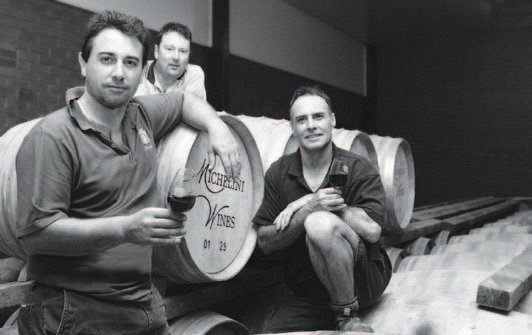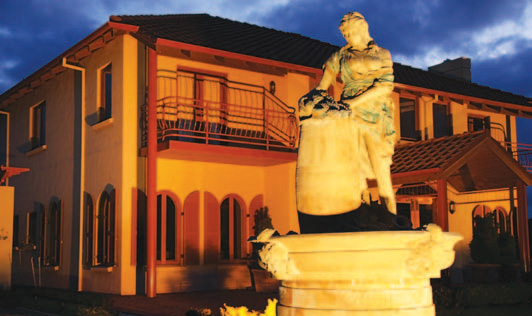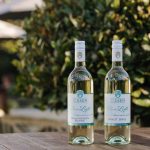By Greg O’Keefe, Winemaker, Michelini Wines, Alpine Valleys, Victoria
First published in the July/August 2013 issue of the Wine & Viticulture Journal
Alpine Valleys producer Michelini Wines planted Marzemino vines in 1991, and has created a single varietal wine since the 1999 vintage. The wine has developed a strong following among the wineries’ wine club patrons.

Marzemino is a red Italian variety found primarily around Isera, south of Trentino in the Alto Adige region of northern Italy. The variety has been found to be a parent of two other varieties grown in the region, Teroldego and La Grein, and is widely regarded for its full body and savoury finish. It is remembered in Mozart’s famous opera Don Giovanni, when Don exclaims of the wine, ‘excellente Marzemino!’
In 1851, the Michelini family began growing grapes and making wine in the Trentino Alto Adige region of the Italian Alps.
In 1949, Emo Michelini arrived in Sydney at the age of 25. Two years later, Emo and his wife Olga moved to the Alpine Valleys region where he began share farming with several other Italian families, growing and curing tobacco before turning his hand to the vine in the Alpine Valleys GI near Porepunkah, nestled between Bright and Mount Buffalo in the Buckland Valley in north-east Victoria.
Viticulture
Initial planting was in 1982 with Chardonnay and Pinot Noir for sparkling base. In 1991, more Chardonnay, Merlot and the little known variety Marzemino was planted with the assistance of Emo’s sons Ilario and Dino.
The site has very old, dark red duplex soils on ancient river terraces that form a ring around Mount Buffalo, which allow for moderate vine vigour. Elevation is around 325m with little slope and not a lot of wind. Temperature data for Bright at 319m elevation shows the mean maximum temperature for February is 29.5°C and minimum 11.4°C. Mean annual rainfall is 1133mm, with almost 50% falling during the growing season of October to April. There is an average of seven days with daily minimum temperatures of less than or equal to 0°C in spring.
Of a total 34.4ha, Marzemino was planted to 0.4ha on Schwarzmann rootstock in 1991. Row orientation is east-west, rows are 3m apart and vines spaced at 2m, providing 1500 vines/ha.
Vines are trained on a double cordon and cane pruned to 40 buds per vine. Fruit is typically thinned after fruitset to allow an even spread along the canes and avoid crowding at the head to allow the fruit to dry out better after a rain event.
The vines are irrigated weekly over the peak of summer using a drip irrigation system with water drawn from the Buckland Valley, which also provides water for the overhead sprinklers to give frost protection in spring.
The rows are mowed regularly during spring to keep the grass down and vines are trimmed to allow for a manageable canopy for disease control and leaf and fruit exposure.
The spray regime depends on the season, however, in addition to the usual copper and sulfur applications, botrytis sprays are always applied at 10% capfall and 80% flowering in case of a difficult wet autumn period. The variety is susceptible to powdery mildew and care has to be taken when conditions are suited to this fungal disease.
Bunches are fairly long with loose, medium-sized berries that are quite dark in colour. This variety requires a long growing season and is typically the last to be harvested in mid-April at around 8t/ha.
In a typical year such as 2010, fruit was picked on 11 April at 12.0 Baume with 5.4g/L TA and pH 3.8, while in the warmer 2013 year it was also picked on 11 April at 13.1 Baume with 6.5 g/L TA and pH
3.7.
Winemaking

The fruit is machine harvested and transferred to the winery in Myrtleford to be crushed into 2t stainless steel open fermenting tanks.
The fruit is allowed to soak for two days with moderate sulphur dioxide addition of around 50ppm prior to the addition of ICV-D254 yeast. Fermentation starts almost immediately and proceeds for about five to seven days on skins with regular pump over at moderate temperature of 25-28°C prior to pressing in a modern airbag press. The wine is transferred to oak in a heated room to complete primary and malolactic fermentation.
Following the fermentation process, the wine is racked to tank and pH adjusted to around 3.5. Then, 100ppm SO2 is added and the wine is transferred to one- and two-year-old French oak barriques.
Minimum SO2 levels of around 40ppm free and 80ppm total are maintained throughout the maturation period.
These wines are typically aged for around 12 months in barrel prior to final filtration and bottle-ageing for several months prior to release.
Wine
In the early years, Marzemino was blended with Merlot. However, since 1999, it has been made as a single varietal wine.
Italian varietal wines typically have firm, drying tannins on the tongue compared with other (most notably French) varietal wines that show much more fruit sweetness, making them more enjoyable when consumed with Italian dishes such as pizza or pasta, or polenta and stew.
In the cellar door, customers remark about the deep red purple colour. The nose displays ripe chocolate, marzipan and cassis notes, with full mouthfeel, persistent flavours and quite firm, drying tannins.
The wine is filled into a standard antique green premium claret bottle with Stelvin finish and is marketed as part of Michelini Wines’ range of Italian varietal wines, including Pinot Grigio and Teroldego (both also from northern Italy), as well as the better known Barbera and Sangiovese.
Sales are predominantly through our cellar door, located on the Great Alpine Road, in Myrtleford, built in the style of a traditional Italian villa.
We do also keep some back vintage stock for wine club members, who are familiar with the variety and are regular buyers.
Marzemino

By Peter Dry, Emeritus Fellow, The Australian Wine Research Institute
Background
Marzemino (marz-amino) is an old variety that may have originated in Veneto and subsequently spread to Trentino, Lombardy, Friuli and Emilia-Romagna. Globally there were 1081 ha in 2010 (up 10% from 2000), close to 100% in Italy. It is now grown mainly in Trentino where it is used in several DOCs, particularly in the Val Lagarina. There is also some in adjacent parts of Lombardy, particularly near Lake Garda, where it is often blended with other varieties; and in Emilia-Romagna and Veneto. DNA profiling indicates that Marzemino and Lagrein are siblings, the parents being Teroldego and an unknown variety. Synonyms include Balsamina, Barzemin, Berzamino, Marzemina Cenerenta, Marzemina Nera and Marzemino Gentile. In Australia there are currently at least 4 wine producers, all in Vic.
Viticulture
Budburst is early mid-season, and maturity is mid-season to late. Growth habit is erect and vigour is high. Bunches are medium, winged, well-filled with blue-black medium berries. Flesh is slightly pink with neutral taste. The skin is said to be thin, but strong. Yield is good and regular with a tendency to overcropping. In Italy cane pruning is most common but it is also said to be suited to mechanized spur pruning. It performs best on on low potential sites and expansive trellis systems that spread out the canopy. Both shoot thinning and bunch thinning are common. It is susceptible to powdery mildew and botrytis bunch rot—with variable reports on susceptibility to downy mildew and lime-induced chlorosis. There is clonal variation for bunch shape and organoleptic characteristics.
Wine
Marzemino is used for both still and sparkling wines in both Italy and Australia. Wines can have intense colour and aroma with good body and full flavor. Tannins are not high. The aftertaste can be slightly bitter. Descriptors include fragrant, fresh, grassy, herbal, red fruits, violets and sour cherry. Wines do not require long ageing but extended maceration can give long-lived wines. In Italy, Marzemino is usually blended with other varieties such as Sangiovese, Merlot and Barbera for DOCs of Trentino, Lombardia, Veneto and Emilia Romagna, e.g. Botticino, Cellatica, Garda, Garda Rosso Classico, Colli di Scandiano e di Canossa. It is also made as a stand-alone varietal for other DOCs, e.g. Trentino Marzemino, Merlara Marzemino, Refrontolo Passito and Breganze Marzemino.




















